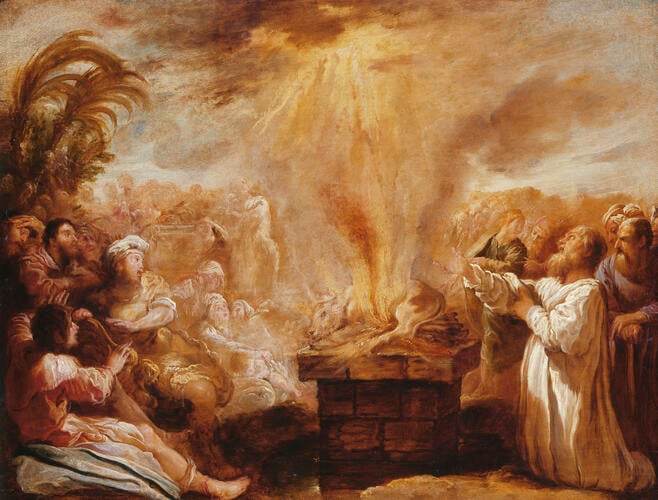The Sacrifice of Elijah Before the Priests of Baal c.1621-22
Oil on panel | 61.2 x 70.5 cm (support, canvas/panel/stretcher external) | RCIN 405466
-
This work, possibly a preparatory sketch for a larger painting, was probably made about the time of Fetti's move to Venice. It was quickly executed, giving the subject a dynamic quality. Elijah, kneeling on the right, looks up at the divine fire that descends upon his sacrificial offering. The worshippers of Baal recoil in horror.
This painting dates to the later period of Fetti's career and was probably executed about the time of his move to Venice in 1622. The work was quickly painted, giving the subject a dynamic quality. Typical of his last paintings in Venice, such as the Flight into Egypt (Kunsthistorisches Museum, Vienna) and the San Simeone (private collection, New York), Fetti used subtle tonal variations to build up the forms contrasted with a dramatic use of chiaroscuro. The small scale of the work and its rapid execution led Nicholas Ivanoff to conclude that it was a bozzetto or preparatory study for a larger painting, though no such painting survives and there are no other examples of old sketches in Fetti's oeuvre.
Based on 1 Kings 18: 38, the painting depicts the sacrifice of Elijah to Jehovah. Elijah kneels in the lower right corner of the painting and looks up at the fire of the Lord that descends upon his sacrificial offering. Opposite him, on the left, those who had been encouraged in the worship of Baal, a false god, recoil in horror as they realise the error of their ways. This rarely depicted Old Testament scene was captured in a woodcut contained in an illustrated bible of 1573 published in Lyon, and it is from this source that Fetti seems to have taken inspiration. Fetti reverses aspects of the woodcut, such as the kneeling figure of Elijah and he eliminates much of the detail in the background, thus tightening the composition. Furthermore, the composition of the upper left-hand portion of the painting demonstrates many similarities with an engraving by Orazio Borgianni of 1615, based on Raphael's fresco of Joseph and his brothers in the Vatican Loggie. Homan Potterman has suggested that Fetti may have studied an engraving by Maerten van Heemskerck.
The painting is described as a 'sacrifice of Noah' in the 1627 inventory in the Palazzo Ducale in Mantua. It was acquired by Charles I and was part of the inventory of the Commonwealth sale in 1649, where it was valued at £3. Subsequently it was sold in 1650 to Robert Turbridge and was later recovered during the Restoration. Although it is clearly attributed to Fetti in the earliest records, during the nineteenth century the artist of the painting was believed to be Aert de Gelder. In 1929, the work was first reattributed by Roberto Longhi and given to Fetti. Only Lehmann has questioned this attribution, considering it the work of an imitator. Painted in Fetti's characteristic technique using quickly applied brushstrokes of colour over more broadly painted areas to create a luminous and shimmering quality, this remarkable painting is patently autograph.
Catalogue entry adapted from The Art of Italy in the Royal Collection: Renaissance and Baroque, London, 2007Provenance
Mentioned in the Gonzaga inventory, 1627; acquired by Charles I; valued at £3 by the Trustees for Sale and sold to Turbridge on 30 April 1650; recovered at the Restoration and listed in the room called 'Paradise' at Hampton Court in 1666 (no 68)
-
Creator(s)
Acquirer(s)
-
Medium and techniques
Oil on panel
Measurements
61.2 x 70.5 cm (support, canvas/panel/stretcher external)
68.4 x 82.3 x 9.6 cm (frame, external)
Category
Object type(s)









